2013 MERCEDES-BENZ SL-CLASS ROADSTER winter tires
[x] Cancel search: winter tiresPage 531 of 572
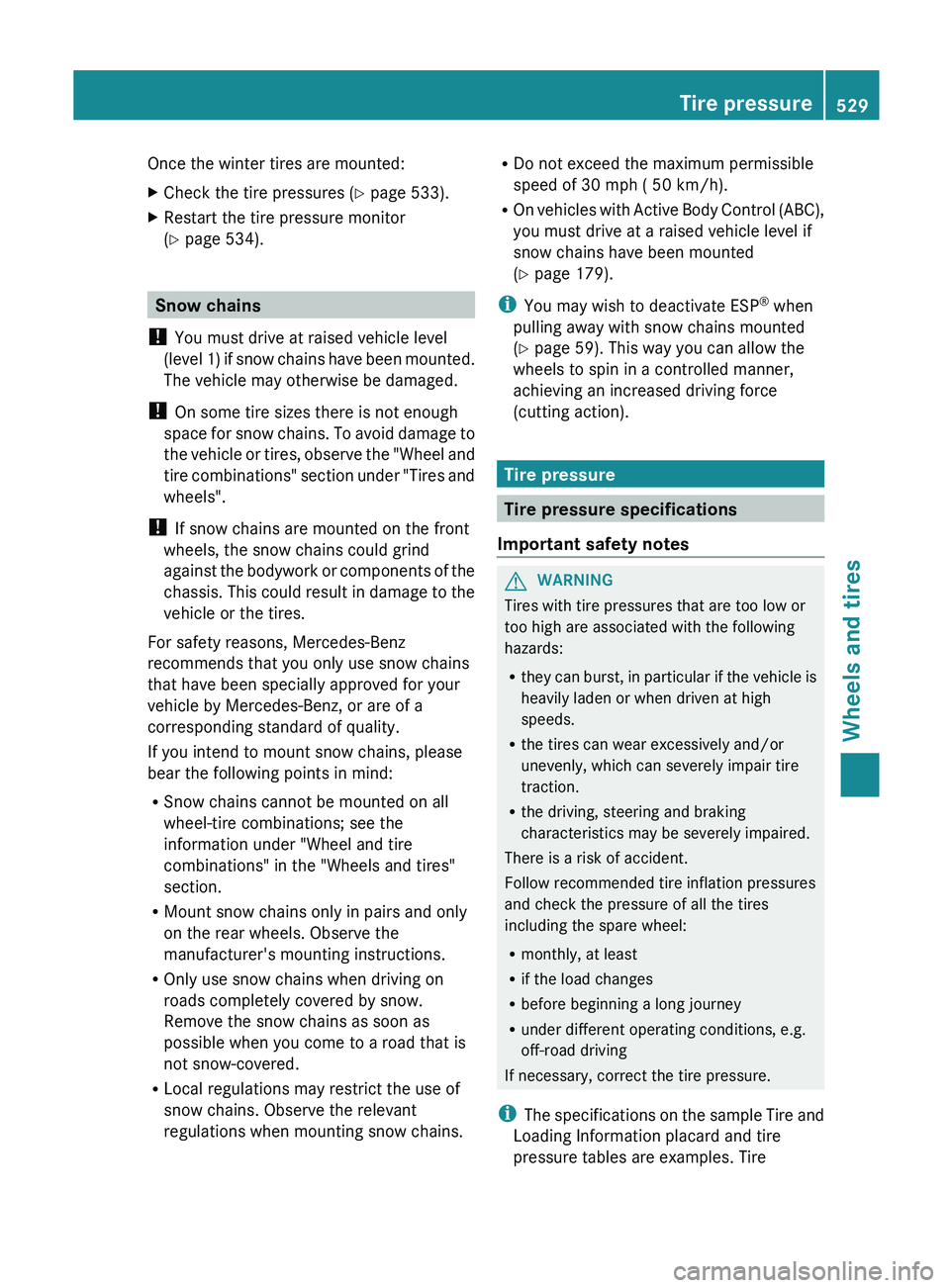
Once the winter tires are mounted:
X
Check the tire pressures (Y page 533).
X Restart the tire pressure monitor
(Y page 534). Snow chains
! You must drive at raised vehicle level
(level 1)
if snow chains have been mounted.
The vehicle may otherwise be damaged.
! On some tire sizes there is not enough
space for snow chains. To avoid damage to
the vehicle or tires, observe the "Wheel and
tire combinations" section under "Tires and
wheels".
! If snow chains are mounted on the front
wheels, the snow chains could grind
against the bodywork or components of the
chassis. This could result in damage to the
vehicle or the tires.
For safety reasons, Mercedes-Benz
recommends that you only use snow chains
that have been specially approved for your
vehicle by Mercedes-Benz, or are of a
corresponding standard of quality.
If you intend to mount snow chains, please
bear the following points in mind:
R Snow chains cannot be mounted on all
wheel-tire combinations; see the
information under "Wheel and tire
combinations" in the "Wheels and tires"
section.
R Mount snow chains only in pairs and only
on the rear wheels. Observe the
manufacturer's mounting instructions.
R Only use snow chains when driving on
roads completely covered by snow.
Remove the snow chains as soon as
possible when you come to a road that is
not snow-covered.
R Local regulations may restrict the use of
snow chains. Observe the relevant
regulations when mounting snow chains. R
Do not exceed the maximum permissible
speed of 30 mph ( 50 km/h).
R On vehicles
with Active Body Control (ABC),
you must drive at a raised vehicle level if
snow chains have been mounted
(Y page 179).
i You may wish to deactivate ESP ®
when
pulling away with snow chains mounted
(Y page 59). This way you can allow the
wheels to spin in a controlled manner,
achieving an increased driving force
(cutting action). Tire pressure
Tire pressure specifications
Important safety notes G
WARNING
Tires with tire pressures that are too low or
too high are associated with the following
hazards:
R they can
burst, in particular if the vehicle is
heavily laden or when driven at high
speeds.
R the tires can wear excessively and/or
unevenly, which can severely impair tire
traction.
R the driving, steering and braking
characteristics may be severely impaired.
There is a risk of accident.
Follow recommended tire inflation pressures
and check the pressure of all the tires
including the spare wheel:
R monthly, at least
R if the load changes
R before beginning a long journey
R under different operating conditions, e.g.
off-road driving
If necessary, correct the tire pressure.
i The specifications on the sample Tire and
Loading Information placard and tire
pressure tables are examples. Tire Tire pressure
529
Wheels and tires Z
Page 542 of 572

All about wheels and tires
Uniform Tire Quality Grading
Standards
Overview of Tire Quality Grading
Standards Uniform Tire Quality Grading Standards are
U.S. government specifications. Their
purpose is to provide drivers with uniform
reliable
information
on tire performance data.
Tire manufacturers have to grade tires using
three performance factors: treadwear
grade :, traction grade ; and temperature
grade =. These regulations do not apply to
Canada. Nevertheless, all tires sold in North
America are provided with the corresponding
quality grading markings on the sidewall of
the tire.
Where applicable, the tire grading
information can be found on the tire sidewall
between the tread shoulder and maximum
tire width.
Example:
R Treadwear grade: 200
R Traction grade: AA
R Temperature grade: A
All passenger car tires must conform to the
statutory safety requirements in addition to
these grades.
i The actual values for tires are vehicle-
specific and may deviate from the values in
the illustration. Treadwear The treadwear grade is a comparative rating
based
on
the wear rate of the tire when tested
under controlled conditions on a specified
U.S. government course. For example, a tire
graded 150 would wear one and one-half
times as well on the government course as a
tire graded 100.
The relative performance of tires depends
upon the actual conditions of their use,
however, and may depart significantly from
the norm, due to variations in driving habits,
service practices and differences in road
characteristics and climate conditions.
Traction G
WARNING
The traction grade assigned to this tire is
based on straight-ahead braking traction
tests, and does not include acceleration,
cornering, hydroplaning, or peak traction
characteristics.
! Avoid wheelspin.
This can lead to damage
to the drive train.
The traction grades, from highest to lowest,
are AA, A, B, and C. Those grades represent
the tire's ability to stop on a wet surface as
measured under controlled conditions on
specified government test surfaces of asphalt
and concrete. A tire marked C may have poor
traction performance.
The safe speed on a wet, snow covered or icy
road is always lower than on dry road
surfaces.
You should pay special attention to road
conditions when temperatures are around
freezing point.
Mercedes-Benz recommends a minimum
tread depth of ã in (4 mm) on all four winter
tires. Observe the legally required minimum
tire tread depth (Y page 527). Winter tires can
reduce the braking distance on snow-covered
surfaces in comparison with summer tires.
The braking distance is still much further than 540
All about wheels and tires
Wheels and tires
Page 543 of 572
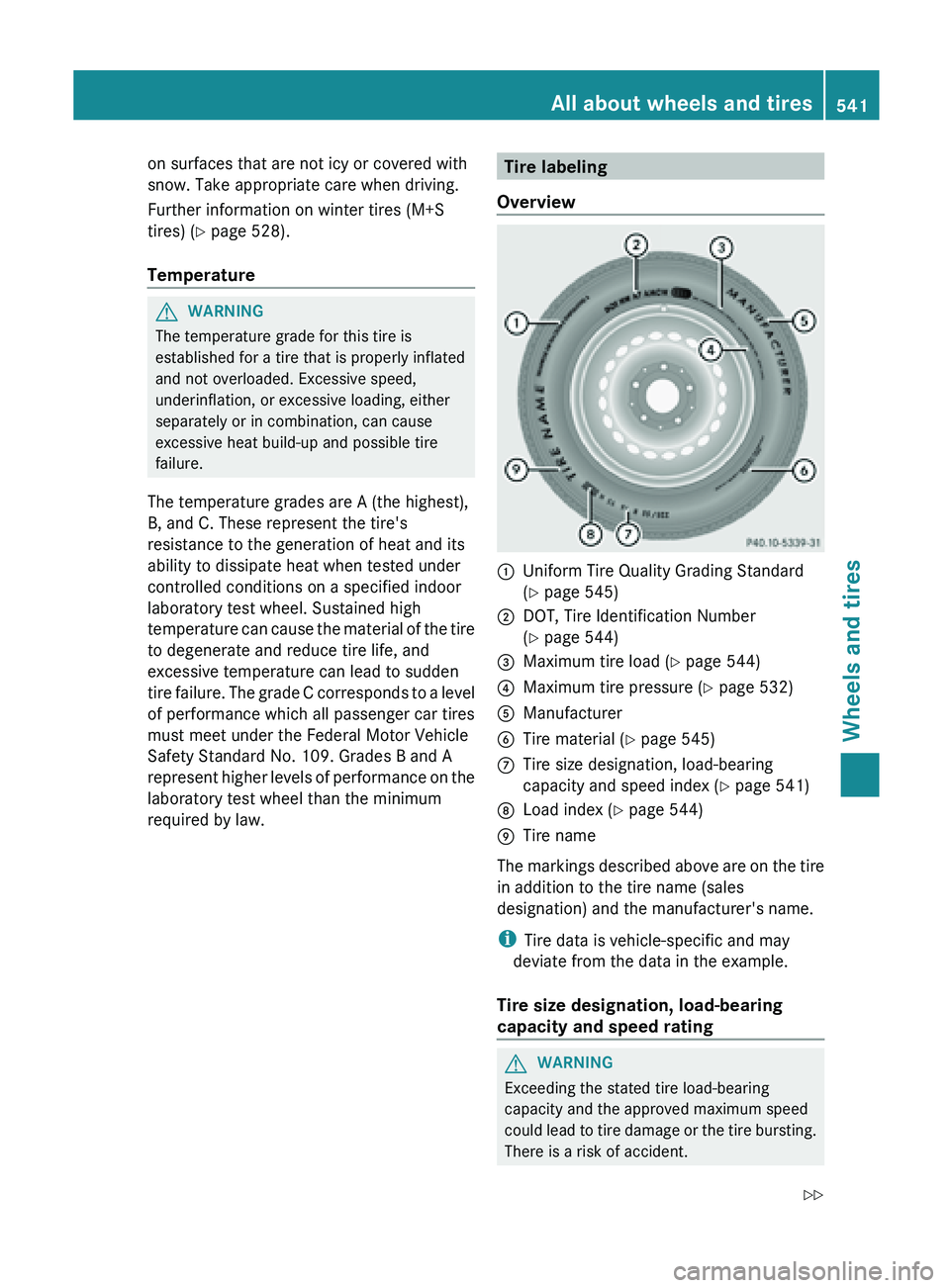
on surfaces that are not icy or covered with
snow. Take appropriate care when driving.
Further information on winter tires (M+S
tires) (Y page 528).
Temperature
G
WARNING
The temperature grade for this tire is
established for a tire that is properly inflated
and not overloaded. Excessive speed,
underinflation, or excessive loading, either
separately or in combination, can cause
excessive heat build-up and possible tire
failure.
The temperature grades are A (the highest),
B, and C. These represent the tire's
resistance to the generation of heat and its
ability to dissipate heat when tested under
controlled conditions on a specified indoor
laboratory test wheel. Sustained high
temperature can
cause the material of the tire
to degenerate and reduce tire life, and
excessive temperature can lead to sudden
tire failure. The grade C corresponds to a level
of performance which all passenger car tires
must meet under the Federal Motor Vehicle
Safety Standard No. 109. Grades B and A
represent higher levels of performance on the
laboratory test wheel than the minimum
required by law. Tire labeling
Overview :
Uniform Tire Quality Grading Standard
(Y page 545)
; DOT, Tire Identification Number
(Y page 544)
= Maximum tire load ( Y page 544)
? Maximum tire pressure (Y page 532)
A Manufacturer
B Tire material ( Y page 545)
C Tire size designation, load-bearing
capacity and speed index (
Y
page 541)
D Load index ( Y page 544)
E Tire name
The markings described above are on the tire
in addition to the tire name (sales
designation) and the manufacturer's name.
i Tire data is vehicle-specific and may
deviate from the data in the example.
Tire size designation, load-bearing
capacity and speed rating G
WARNING
Exceeding the stated tire load-bearing
capacity and the approved maximum speed
could lead
to tire damage or the tire bursting.
There is a risk of accident. All about wheels and tires
541
Wheels and tires
Z
Page 545 of 572
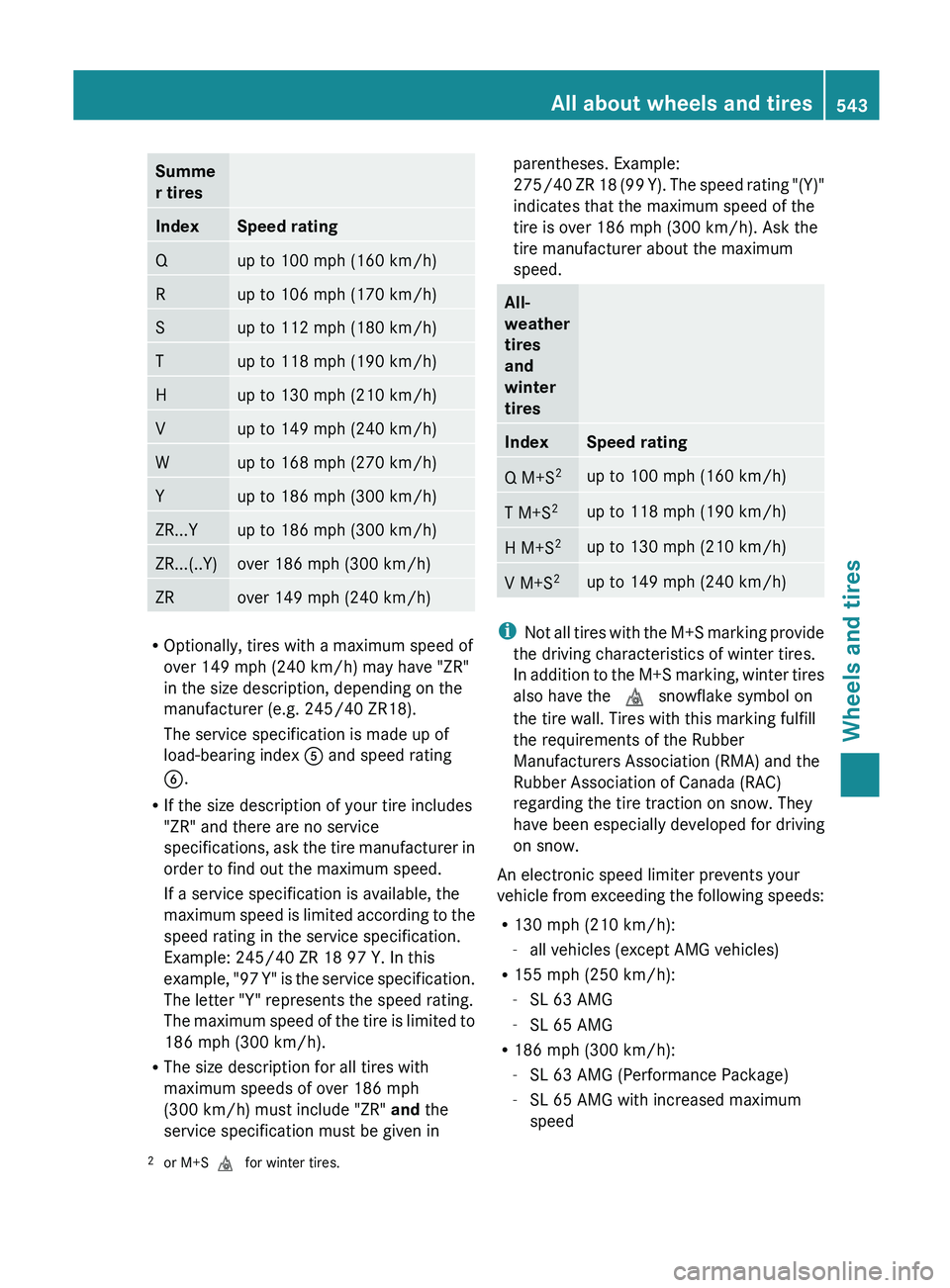
Summe
r tires
Index Speed rating
Q up to 100 mph (160 km/h)
R up to 106 mph (170 km/h)
S up to 112 mph (180 km/h)
T up to 118 mph (190 km/h)
H up to 130 mph (210 km/h)
V up to 149 mph (240 km/h)
W up to 168 mph (270 km/h)
Y up to 186 mph (300 km/h)
ZR...Y up to 186 mph (300 km/h)
ZR...(..Y) over 186 mph (300 km/h)
ZR over 149 mph (240 km/h)
R
Optionally, tires with a maximum speed of
over 149 mph (240 km/h) may have "ZR"
in the size description, depending on the
manufacturer (e.g. 245/40 ZR18
).
The service specification is made up of
load-bearing index A and speed rating
B.
R If the size description of your tire includes
"ZR" and there are no service
specifications, ask the tire manufacturer in
order to find out the maximum speed.
If a service specification is available, the
maximum speed is limited according to the
speed rating in the service specification.
Example: 245/40 ZR 18 97 Y. In this
example, "97 Y" is the service specification.
The letter "Y" represents the speed rating.
The maximum speed of the tire is limited to
186 mph (300 km/h).
R The size description for all tires with
maximum speeds of over 186 mph
(300 km/h) must include "ZR" and the
service specification must be given in parentheses. Example:
275/40
ZR
18 (99 Y). The speed rating "(Y)"
indicates that the maximum speed of the
tire is over 186 mph (300 km/h). Ask the
tire manufacturer about the maximum
speed. All-
weather
tires
and
winter
tires
Index Speed rating
Q M+S
2 up to 100 mph (160 km/h)
T M+S
2 up to 118 mph (190 km/h)
H M+S
2 up to 130 mph (210 km/h)
V M+S
2 up to 149 mph (240 km/h)
i
Not all
tires with the M+S marking provide
the driving characteristics of winter tires.
In addition to the M+S marking, winter tires
also have the i snowflake symbol on
the tire wall. Tires with this marking fulfill
the requirements of the Rubber
Manufacturers Association (RMA) and the
Rubber Association of Canada (RAC)
regarding the tire traction on snow. They
have been especially developed for driving
on snow.
An electronic speed limiter prevents your
vehicle from exceeding the following speeds:
R 130 mph (210 km/h):
-all vehicles (except AMG vehicles)
R 155 mph (250 km/h):
-SL 63 AMG
- SL 65 AMG
R 186 mph (300 km/h):
-SL 63 AMG (Performance Package)
- SL 65 AMG with increased maximum
speed
2 or M+S i for winter tires. All about wheels and tires
543
Wheels and tires Z
Page 555 of 572
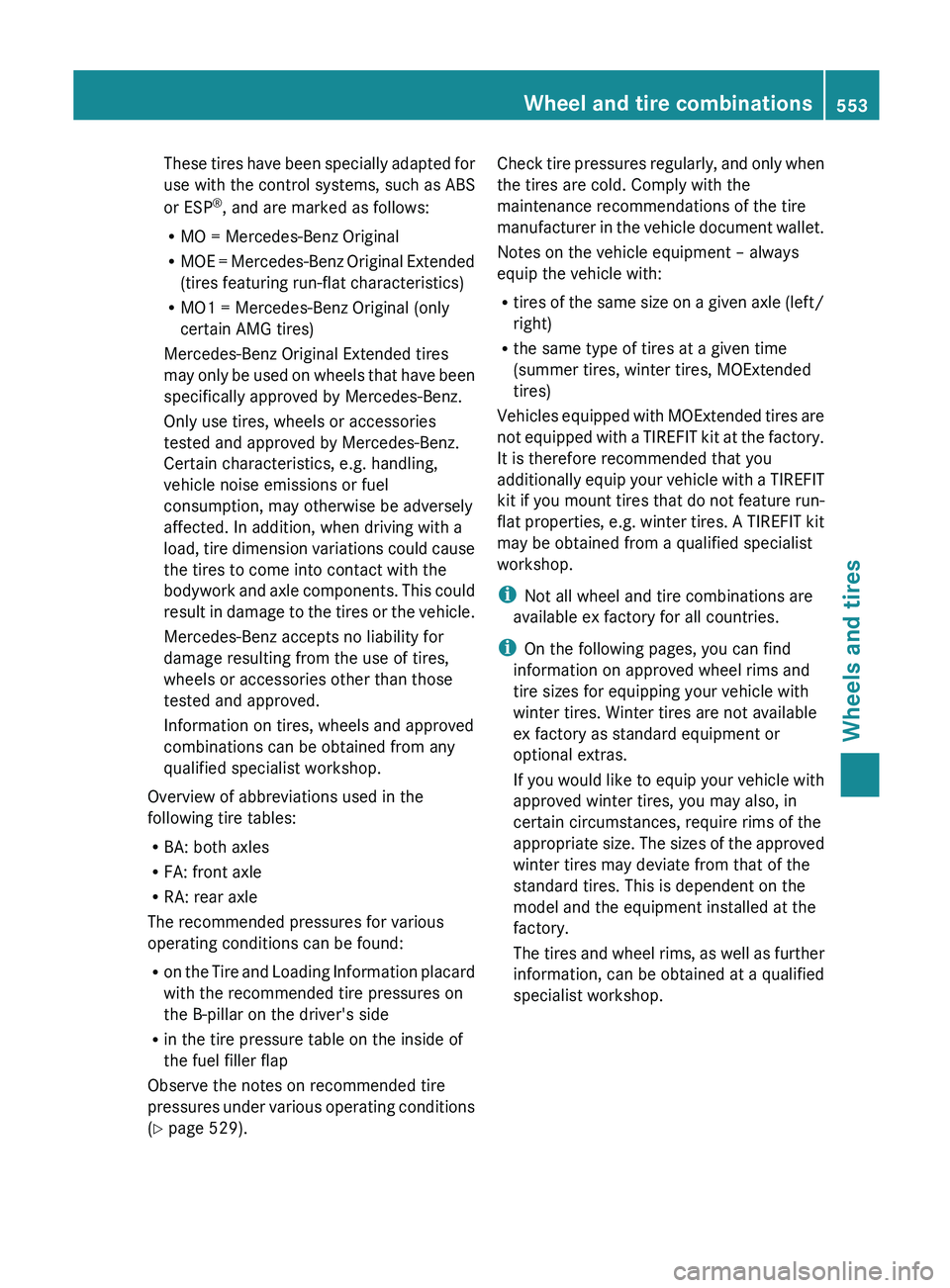
These tires have been specially adapted for
use with the control systems, such as ABS
or ESP
®
, and are marked as follows:
R MO = Mercedes-Benz Original
R MOE =
Mercedes-Benz Original Extended
(tires featuring run-flat characteristics)
R MO1 = Mercedes-Benz Original (only
certain AMG tires)
Mercedes-Benz Original Extended tires
may only be used on wheels that have been
specifically approved by Mercedes-Benz.
Only use tires, wheels or accessories
tested and approved by Mercedes-Benz.
Certain characteristics, e.g. handling,
vehicle noise emissions or fuel
consumption, may otherwise be adversely
affected. In addition, when driving with a
load, tire dimension variations could cause
the tires to come into contact with the
bodywork and axle components. This could
result in damage to the tires or the vehicle.
Mercedes-Benz accepts no liability for
damage resulting from the use of tires,
wheels or accessories other than those
tested and approved.
Information on tires, wheels and approved
combinations can be obtained from any
qualified specialist workshop.
Overview of abbreviations used in the
following tire tables:
R BA: both axles
R FA: front axle
R RA: rear axle
The recommended pressures for various
operating conditions can be found:
R on the Tire and Loading Information placard
with the recommended tire pressures on
the B-pillar on the driver's side
R in the tire pressure table on the inside of
the fuel filler flap
Observe the notes on recommended tire
pressures under various operating conditions
(Y page 529). Check tire pressures regularly, and only when
the tires are cold. Comply with the
maintenance recommendations of the tire
manufacturer in
the vehicle document wallet.
Notes on the vehicle equipment – always
equip the vehicle with:
R tires of the same size on a given axle (left/
right)
R the same type of tires at a given time
(summer tires, winter tires, MOExtended
tires)
Vehicles equipped with MOExtended tires are
not equipped with a TIREFIT kit at the factory.
It is therefore recommended that you
additionally equip your vehicle with a TIREFIT
kit if you mount tires that do not feature run-
flat properties, e.g. winter tires. A TIREFIT kit
may be obtained from a qualified specialist
workshop.
i Not all wheel and tire combinations are
available ex factory for all countries.
i On the following pages, you can find
information on approved wheel rims and
tire sizes for equipping your vehicle with
winter tires. Winter tires are not available
ex factory as standard equipment or
optional extras.
If you would like to equip your vehicle with
approved winter tires, you may also, in
certain circumstances, require rims of the
appropriate size. The sizes of the approved
winter tires may deviate from that of the
standard tires. This is dependent on the
model and the equipment installed at the
factory.
The tires and wheel rims, as well as further
information, can be obtained at a qualified
specialist workshop. Wheel and tire combinations
553
Wheels and tires Z
Page 557 of 572
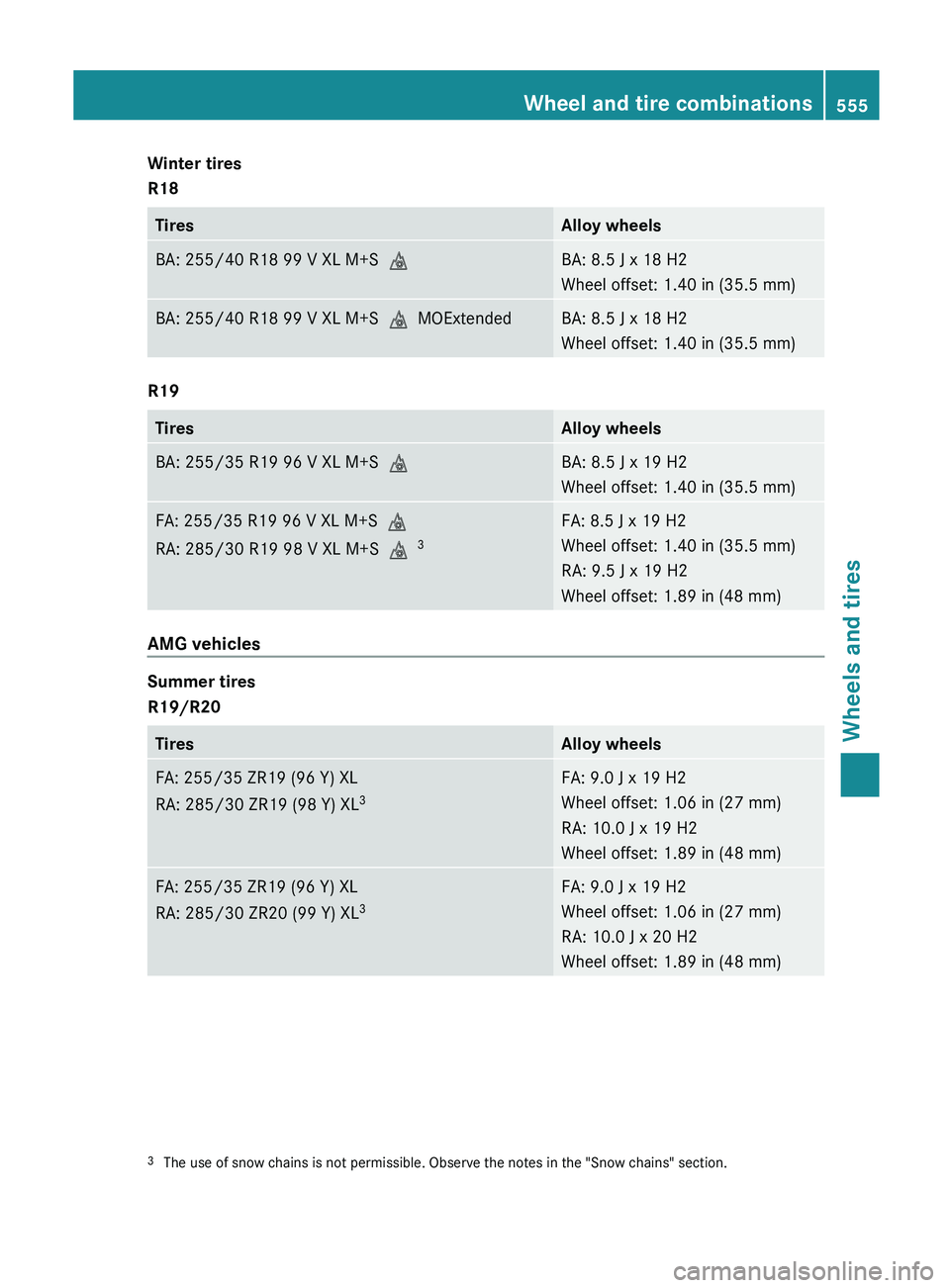
Winter tires
R18
Tires Alloy wheels
BA: 255/40 R18 99 V XL M+S
i BA: 8.5 J x 18 H2
Wheel offset: 1.40 in
(35.5 mm
)BA: 255/40 R18 99 V XL M+S
iMOExtended BA: 8.5 J x 18 H2
Wheel offset: 1.40 in
(35.5 mm
)R19
Tires Alloy wheels
BA: 255/35 R19 96 V XL M+S
i BA: 8.5 J x 19 H2
Wheel offset: 1.40 in
(35.5 mm
)FA: 255/35 R19 96 V XL M+S
i
RA: 285/30 R19 98 V XL M+S i3 FA: 8.5 J x 19 H2
Wheel offset: 1.40 in
(35.5 mm
)
RA: 9.5 J x 19 H2
Wheel offset: 1.89 in (48 mm) AMG vehicles
Summer tires
R19/R20
Tires Alloy wheels
FA: 255/35 ZR19 (96 Y) XL
RA: 285/30
ZR19 (98 Y) XL 3 FA: 9.0 J x 19 H2
Wheel offset: 1.06 in
(27 mm)
RA: 10.0 J x 19 H2
Wheel offset: 1.89 in
(48 mm)FA: 255/35 ZR19 (96 Y) XL
RA: 285/30
ZR20 (99 Y) XL 3 FA: 9.0 J x 19 H2
Wheel offset: 1.06 in
(27 mm)
RA: 10.0 J x 20 H2
Wheel offset: 1.89 in
(48 mm)3
The use of snow chains is not permissible. Observe the notes in the "Snow chains" section. Wheel and tire combinations
555
Wheels and tires Z
Page 558 of 572
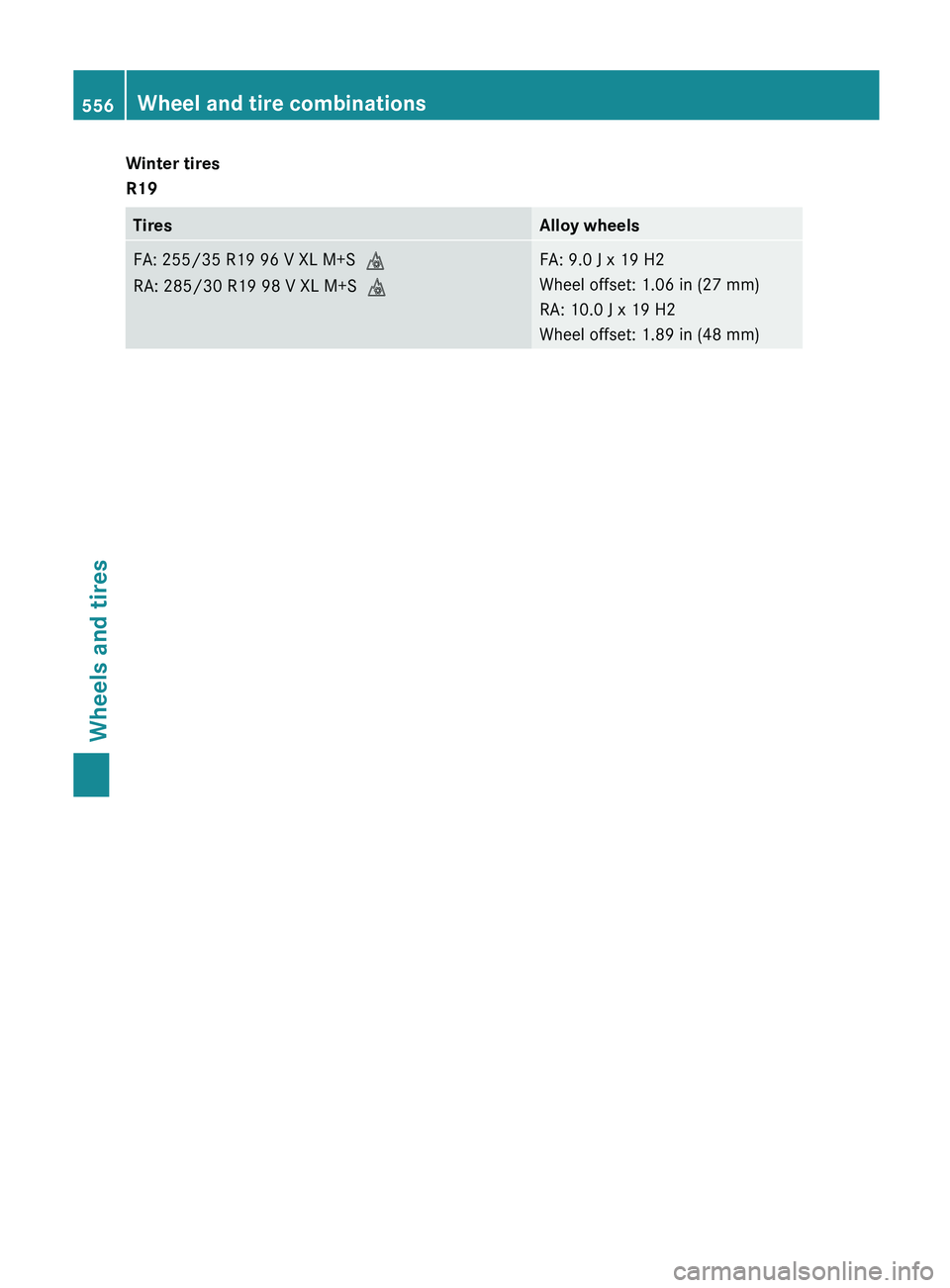
Winter tires
R19
Tires Alloy wheels
FA: 255/35 R19 96 V XL M+S
i
RA: 285/30 R19 98 V XL M+S i FA: 9.0 J x 19 H2
Wheel offset: 1.06 in
(27 mm)
RA: 10.0 J x 19 H2
Wheel offset: 1.89 in
(48 mm)556
Wheel and tire combinations
Wheels and tires
Page 567 of 572

!
Do not
add distilled or de-ionized water to
the washer fluid container. Otherwise, the
level sensor may be damaged.
! Only MB SummerFit and MB WinterFit
washer fluid should be mixed together. The
spray nozzles may otherwise become
blocked.
At temperatures above freezing:
X Fill the washer fluid reservoir with a mixture
of water and windshield washer fluid, e.g.
MB SummerFit.
X Add 1 part MB SummerFit to 100 parts
water.
At temperatures below freezing:
X Fill the washer fluid reservoir with a mixture
of water and windshield washer fluid, e.g.
MB WinterFit.
Adapt the mixing ratio to the
outside temperature.
X Down to 14 ‡ (Ò10 †): mix 1 part MB
WinterFit with 2 parts water.
X Down to Ò4 ‡ (Ò20 †): mix 1 part MB
WinterFit with 1 part water.
X Down to Ò20.2 ‡ (
Ò29 †): mix 2 parts MB
WinterFit with 1 part water. Model Capacity
All models
5.6 US qt(5.3 l)
i
Add windshield washer fluid, e.g. MB
SummerFit or MB WinterFit, to the washer
fluid all year round. Vehicle data
General notes
Please note that for the specified vehicle
data:
R The heights specified may vary as a result
of:
-tires
- load
- condition of the suspension
- optional equipment
R The vehicle length specified includes the
front license plate adapter. Dimensions and weights
All models (except
AMG vehicles)
:Opening height 75.8 in (1925 mm)
AMG vehicles
:Opening height 75.6 in – 79.3 in
(1921 mm –2013 mm ) Vehicle data
565
Technical data Z